with Scott McCorley
An FO is someone who spots for the artillery unit or battery and their primary role is to guide the rounds on target with the help of a laser range finder that gives a 10 figure grid reference, or with a tested method of map to ground with the help of an artillery protractor and a 8 figure grid reference.
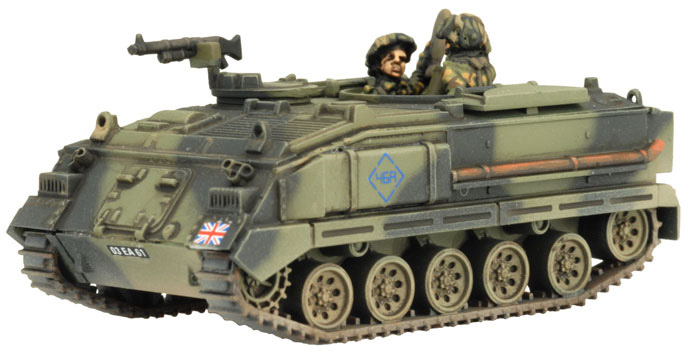
(Joint Terminal Attack Control) for strike aircraft.
So how does this become relevant in our games of WWIII: Team Yankee? There are many ways our FOs can be used in our games be it to spot or range in on a new viable target location. Having our FOs in cover and in prime position with good line of sight is a must for the continued use of our artillery in subsequent turns. Having an FO twill help with the +1 to range going a long way, especially if your target may be in short or tall terrain or covered by a smoke screen. Remember, any team leader can also spot for your artillery but only the FO has the +1 to range in.
Now let’s move onto the Artillery and what the FO has to work with out in the field.
So using your artillery on the enemy infantry is a good start as it can prepare the way for your own infantry or tanks for an assault, but can also pin enemy infantry down, and is very useful if there are any ATGM (Anti-Tank Guided Missiles) in the unit. Now if you are going to use your artillery to help launch an assault this can be tricky as it requires some good judgment on the template and ranging in so that you won’t get that danger close or within 4” of the template with any of your teams.

As most tanks have a top armour of two it makes it hard to destroy them, and the chance of making them bail quite low so it’s best to leave heavy armour to the dedicated anti- tank units like milians and spandrels. The best use in this case is to go after soft skinned AFVs as their top armour is ether one or zero and if it’s a transport a good chance to take out some pesky infantry as well. Also of the opportunity arise direct fire is also good against AFVs as most SPs artillery (self-propelled guns) have a good AT and FP to destroy them.
So that’s two ways of basic use of artillery and our FO, but here is where things can get interesting.
Other types of arty like the rockets, mortars and special shells, deployment of arty, the use of ranged in markers for certain missions and smoke bombardments is where we’re headed next. First of the different types and how to use them.
Rockets are great for coverage and area suppression of a target being a salvo rather than arty, so a bigger template. This is great for getting large blobs of infantry or AFVs that are too spread out for normal arty to target and hit, even better now with the new weapon system like the British MRLS.
Now once again don’t think you will be able to destroy tanks, as rockets tend to have a low AT rating.
Next up the mortar. Mortars like rockets don’t have the AT rating so don’t expect them to take out tanks or AFVs in droves. Best use for these is to lay down some smoke to ether get your infantry in position for an assault or to cover a flank of your precious tanks from enemy AT fire while they advance. Also don’t forget if they are targeting infantry repeat that bombardment next turn to make them more effective.
Now onto the special shells. While all types of special ammo will require you to pay the extra points, what you want to know is it worth taking. Well yes and no, first let’s talk about the types, most arty like the M109s and the 2S3s give you the option to take thing like copperhead rounds or the reds equivalent. The drawback to these is its either direct fire which requires line of sight or an FO to guide it onto the target. Great for tanks as it has a higher AT than normal and gives you a better chance to do damage to them.
Next up minelets, oh boy do I love these! The best job for mines is choke points- good old choke points. For those of you not military-minded a choke point is where you funnel the enemy into a kill zone so you can wipe them out or manage a larger force by a smaller one. So for example West Germans, Leo 2 Company up against a BMP horde. Just seeing this can give a player nightmares but with the use of minelets you can force your opponent to reposition their units around the mines and giving you the best use of your guns. Best used in conjunction with the terrain as well to achieve that choke-point.
Bomblets operate on the same principal as rockets, great for suppression.
Also don’t forget Smoke bombardments as these are great for covering the advance of your forces especially out in the open.
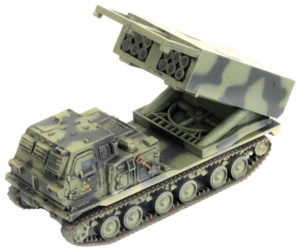
advise against it as your arty is very soft skinned and prone to being destroyed if able to be seen. The other one is the deployment of the ranged in marker at the start of deployment for certain missions, if placed well can give you an advantage from the start. Choosing were to place it can be difficult but if placed in a wood in the enemy deployment zone this can then deter infantry and keep them pinned from turn one, it also helps avoid the +1 to range in for the template if it touches short or tall terrain and smoke.
Another is to place it in the most likely axis of advance of the enemy’s route as it can force them to rethink how to move and allow you to set up that all important choke point. So that is some of the uses for arty and FO’s.
Lastly weighing up the cost of arty to things like air support it can become a difficult choice, especially if you are a Soviet or East German player, NATO players might find it a bit easier. At the end of the day it comes down to what role you want them for, be it cheap mortars and rockets for suppression and smoke or arty for range and the direct fire just in case things start to look bad.
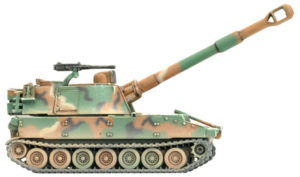
So enjoy and happy spotting.

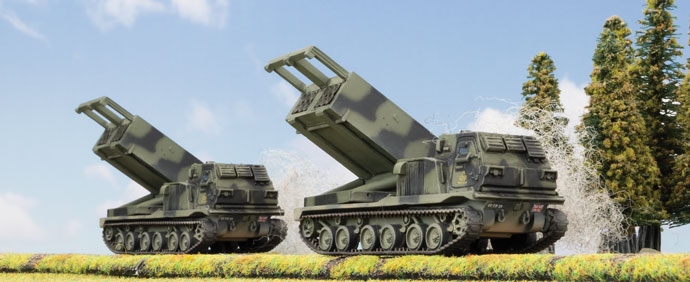
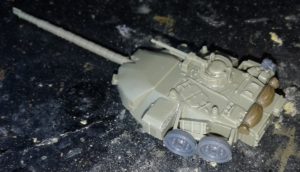 The backstory that I developed was that this force would be part of a British task force sent to the Middle East as part of the NATO/Western contingent taking part in the battle to halt the Soviet juggernaut using Iran as an invasion corridor in order to seize vital Oil resources, denying them from western forces embattled on the battlefields of Germany.
The backstory that I developed was that this force would be part of a British task force sent to the Middle East as part of the NATO/Western contingent taking part in the battle to halt the Soviet juggernaut using Iran as an invasion corridor in order to seize vital Oil resources, denying them from western forces embattled on the battlefields of Germany.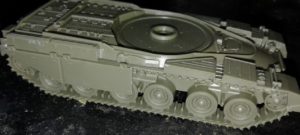
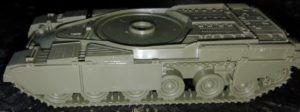
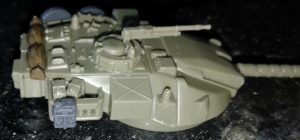
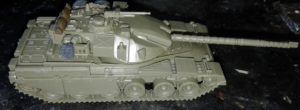 Step 1:
Step 1: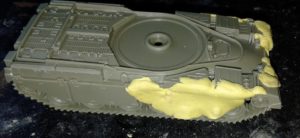
 Step 2: After building the base of the ‘canvas’ I decided that I wanted the vehicle to be liberally draped in ‘Barracuda’ type camouflage nets much like one sees pictures of British military vehicles on field exercises from the era. So I created the basic shapes of the nets with very thin pieces of Miliput modelling putty in various spots of the hull and turret as well as wrapped around the gun tube, being careful to try and avoid blocking optics or access hatches.
Step 2: After building the base of the ‘canvas’ I decided that I wanted the vehicle to be liberally draped in ‘Barracuda’ type camouflage nets much like one sees pictures of British military vehicles on field exercises from the era. So I created the basic shapes of the nets with very thin pieces of Miliput modelling putty in various spots of the hull and turret as well as wrapped around the gun tube, being careful to try and avoid blocking optics or access hatches.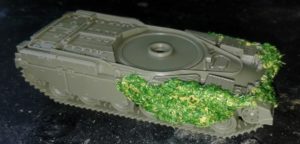 Step 3: With the basic shapes and locations of the camouflage nets in place, I then add the ‘leaf’ type texture of the net by brushing the dried Miliput with heavily watered down white glue. Then I cover these parts of the model with model railway ground clutter, and fix this in place by touching the ‘nets’ with a second coat of even more heavily watered down white glue, before leaving it to dry.
Step 3: With the basic shapes and locations of the camouflage nets in place, I then add the ‘leaf’ type texture of the net by brushing the dried Miliput with heavily watered down white glue. Then I cover these parts of the model with model railway ground clutter, and fix this in place by touching the ‘nets’ with a second coat of even more heavily watered down white glue, before leaving it to dry.
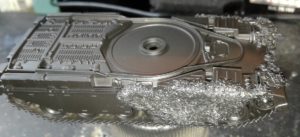
 Step 5: Next I sprayed an all over coat of Vallejo Model Air 71.011 (Dark Green RLM83) as the base green for the camouflage pattern.
Step 5: Next I sprayed an all over coat of Vallejo Model Air 71.011 (Dark Green RLM83) as the base green for the camouflage pattern.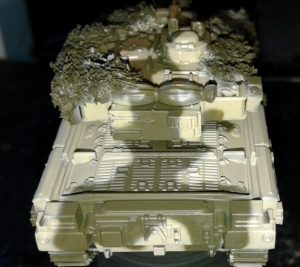
 Step 6: After the base green dried I added the camouflage pattern using Vallejo Model Air 71.143 (UK Light Stone BS361). In keeping with photographic records the scheme is random, but applied in such a way as to ‘break up’ the shape of the vehicle when viewed from a distance. At this stage I also elected to keep one of the armour skirt sections in the base green to give the impression of a replacement plate having been added but not painted camouflage.
Step 6: After the base green dried I added the camouflage pattern using Vallejo Model Air 71.143 (UK Light Stone BS361). In keeping with photographic records the scheme is random, but applied in such a way as to ‘break up’ the shape of the vehicle when viewed from a distance. At this stage I also elected to keep one of the armour skirt sections in the base green to give the impression of a replacement plate having been added but not painted camouflage. Step 7: After applying the camouflage pattern to the model I highlight the raised details and the edges of the model with an all over drybrush of Vallejo Model Color 70.837 (Pale Sand). While this is a very light colour to highlight the model with, it almost disappears on the finished product, but adds just a hint of definition. It also has the added benefit of slightly fading the two main colours.
Step 7: After applying the camouflage pattern to the model I highlight the raised details and the edges of the model with an all over drybrush of Vallejo Model Color 70.837 (Pale Sand). While this is a very light colour to highlight the model with, it almost disappears on the finished product, but adds just a hint of definition. It also has the added benefit of slightly fading the two main colours.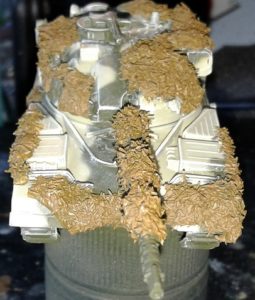
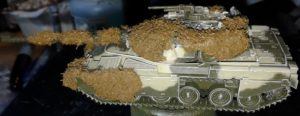 Step 8: I start painting the colour of the netting. In this case I went for the brown side out due to the arid nature of the battlefield, so started with a
Step 8: I start painting the colour of the netting. In this case I went for the brown side out due to the arid nature of the battlefield, so started with a
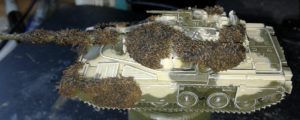
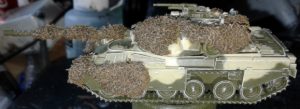
 Step 12: Next I paint the tracks and main armament muzzle using Vallejo Model Air 71.251 (NATO Black).
Step 12: Next I paint the tracks and main armament muzzle using Vallejo Model Air 71.251 (NATO Black).
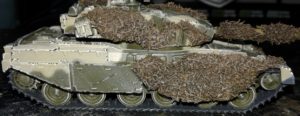



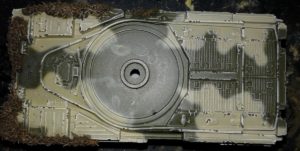
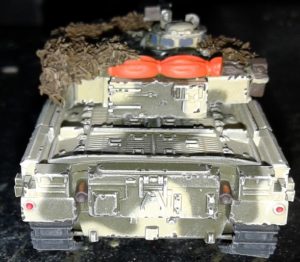
 Step 15: At this point I paint all the smaller details.
Step 15: At this point I paint all the smaller details.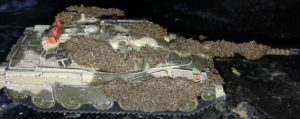
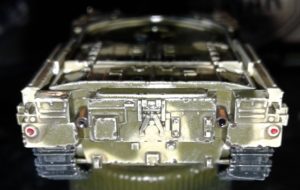
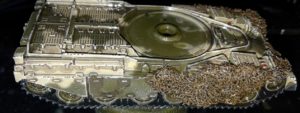

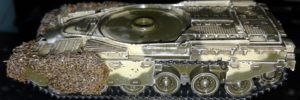
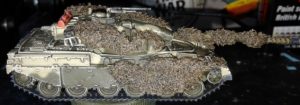
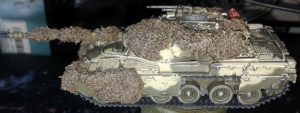
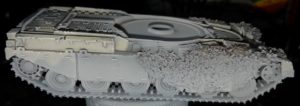

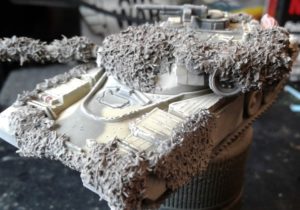
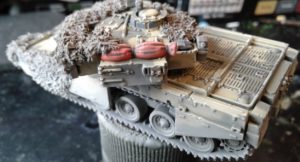





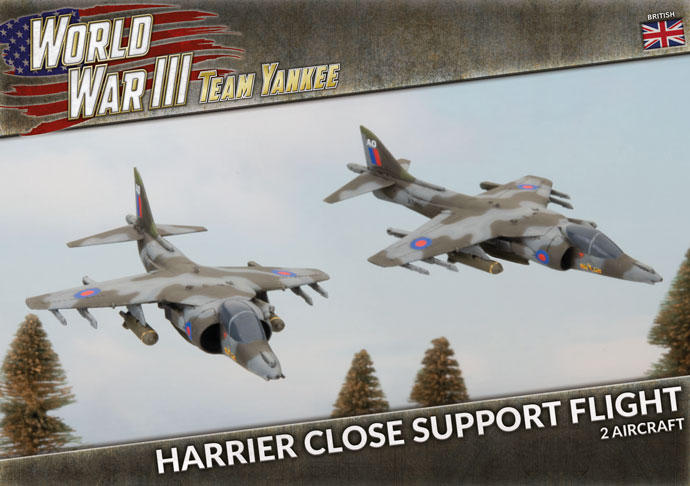
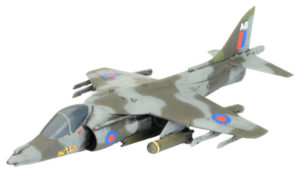 Being the first of the new WWIII: Team Yankee releases, the British are the first force to get their very own plastic aircraft, the Iron Division Harrier Close Air Support Flight. The famous ‘Jump Jet’ used by the British in World War III could swivel its exhaust nozzles down to allow it to take off vertically. As such, it was based out of supermarket car-parks, football fields, or other concealed locations close to the front line to reduce interference from Soviet intercepting aircraft, and to keep the rate of sorties higher than conventional aircraft.
Being the first of the new WWIII: Team Yankee releases, the British are the first force to get their very own plastic aircraft, the Iron Division Harrier Close Air Support Flight. The famous ‘Jump Jet’ used by the British in World War III could swivel its exhaust nozzles down to allow it to take off vertically. As such, it was based out of supermarket car-parks, football fields, or other concealed locations close to the front line to reduce interference from Soviet intercepting aircraft, and to keep the rate of sorties higher than conventional aircraft.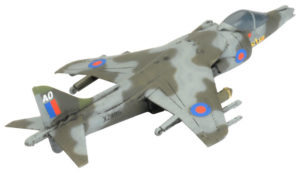 The Harrier Close Air Support Flight is an effective attack aircraft, boasting both the 30mm Aden gun and the BL-755 cluster bombs. The Harrier’s role in destroying lighter vehicles, helicopters, and dropping cluster bombs on infantry is a key support role, made all the more easy to model, paint, and field, with the new plastic kit.
The Harrier Close Air Support Flight is an effective attack aircraft, boasting both the 30mm Aden gun and the BL-755 cluster bombs. The Harrier’s role in destroying lighter vehicles, helicopters, and dropping cluster bombs on infantry is a key support role, made all the more easy to model, paint, and field, with the new plastic kit.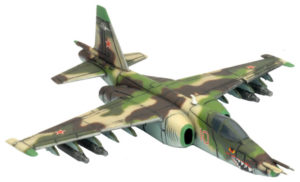 The SU-25 Frogfoot The Sukhoi Su-25 Frogfoot, known to its crew as the Grach (‘Rook’), is the modern-day equivalent of the legendary WWII Il-2 Shturmovik. It’s tough and sturdy, able to sustain multiple hits and still bring its pilot home. Flying low and slow, it can safely attack enemy troops in close proximity to its own. The SU-25 carries an impressive array of weaponry, including air-to-surface missiles and unguided rockets, on its ten under-wing hardpoints, as well as having a twin-barrelled GSh‑30-2 30mm cannon in the nose. The KH-25 Missiles come as a resin cast set of add-on pieces to make modelling your full kitted out Frogfoot easy.
The SU-25 Frogfoot The Sukhoi Su-25 Frogfoot, known to its crew as the Grach (‘Rook’), is the modern-day equivalent of the legendary WWII Il-2 Shturmovik. It’s tough and sturdy, able to sustain multiple hits and still bring its pilot home. Flying low and slow, it can safely attack enemy troops in close proximity to its own. The SU-25 carries an impressive array of weaponry, including air-to-surface missiles and unguided rockets, on its ten under-wing hardpoints, as well as having a twin-barrelled GSh‑30-2 30mm cannon in the nose. The KH-25 Missiles come as a resin cast set of add-on pieces to make modelling your full kitted out Frogfoot easy.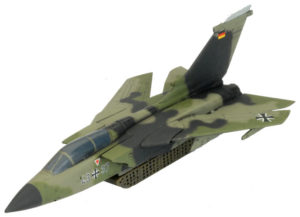 The Tornado is the third plastic kit being made available right off the bat for WWIII: Team Yankee. The Tornado is a two spruce plastic kit, with a plastic cockipit, and a resin MW-1 Submunition Dispenser cast by us to add to the kit. The main role of the Tornado is as an Interdictor Strike (IDS) aircraft. The Tornado is armed with two internally mounted 27mm Mauser BK-27 auto-cannons and two AIM-9 Sidewinder missiles for self-defence. It can carry a variety of conventional bombs, as well as the MW-1 submunition dispenser that drops a variety of munitions, including the KB44 anti tank bomblet.
The Tornado is the third plastic kit being made available right off the bat for WWIII: Team Yankee. The Tornado is a two spruce plastic kit, with a plastic cockipit, and a resin MW-1 Submunition Dispenser cast by us to add to the kit. The main role of the Tornado is as an Interdictor Strike (IDS) aircraft. The Tornado is armed with two internally mounted 27mm Mauser BK-27 auto-cannons and two AIM-9 Sidewinder missiles for self-defence. It can carry a variety of conventional bombs, as well as the MW-1 submunition dispenser that drops a variety of munitions, including the KB44 anti tank bomblet. One of the biggest additions to the British WWIII book (in my own humble opinion), is the inclusion of the FV510 Warrior. A massive improvement over the FV432 in a whole whack of ways. With the addition of the Warrior the British army now have the personnel carriers to support their infantry
One of the biggest additions to the British WWIII book (in my own humble opinion), is the inclusion of the FV510 Warrior. A massive improvement over the FV432 in a whole whack of ways. With the addition of the Warrior the British army now have the personnel carriers to support their infantry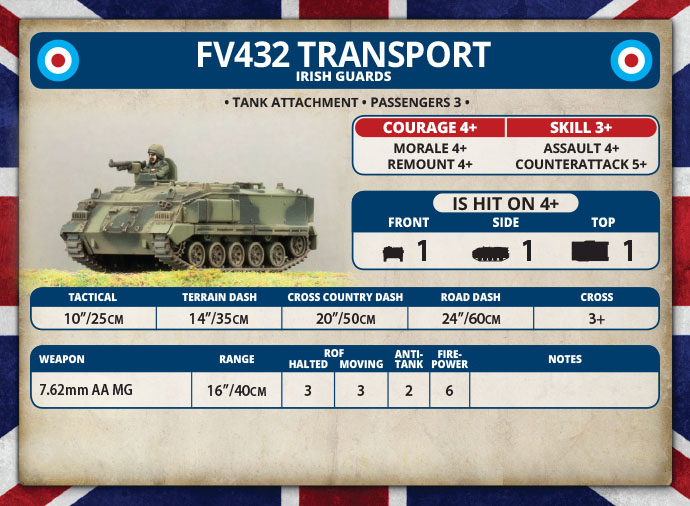 My go-to force for WWIII ever since the Brits were released; the British Mechanised Infantry force were rock-solid in defence, able to bring a number of Milan Missiles to bear against their opponent, backed up by the effective Carl Gustav recoilless launchers should any Warsaw Pact medium tanks get foolish enough to assault the dug-in positions. But what of the actual 432s themselves? Well, I will be perfectly honest here, my 432s almost never saw the table; the risk of the paper-thin armour, lack of armament (not even having the ability to mount a Milan), led to them being used as quick-dash taxis if needed. I would mount up, dash them as quickly and safely as I could, before dumping the infantry off next turn and getting the 432s as far away (usually off the table) as I could to prevent them being easy targets for enemy APCs/AFVs.
My go-to force for WWIII ever since the Brits were released; the British Mechanised Infantry force were rock-solid in defence, able to bring a number of Milan Missiles to bear against their opponent, backed up by the effective Carl Gustav recoilless launchers should any Warsaw Pact medium tanks get foolish enough to assault the dug-in positions. But what of the actual 432s themselves? Well, I will be perfectly honest here, my 432s almost never saw the table; the risk of the paper-thin armour, lack of armament (not even having the ability to mount a Milan), led to them being used as quick-dash taxis if needed. I would mount up, dash them as quickly and safely as I could, before dumping the infantry off next turn and getting the 432s as far away (usually off the table) as I could to prevent them being easy targets for enemy APCs/AFVs.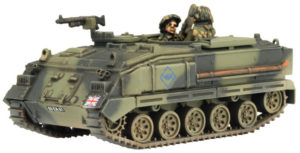 Strengths: Larger units (by comparison), for less points, plenty of Milan support
Strengths: Larger units (by comparison), for less points, plenty of Milan support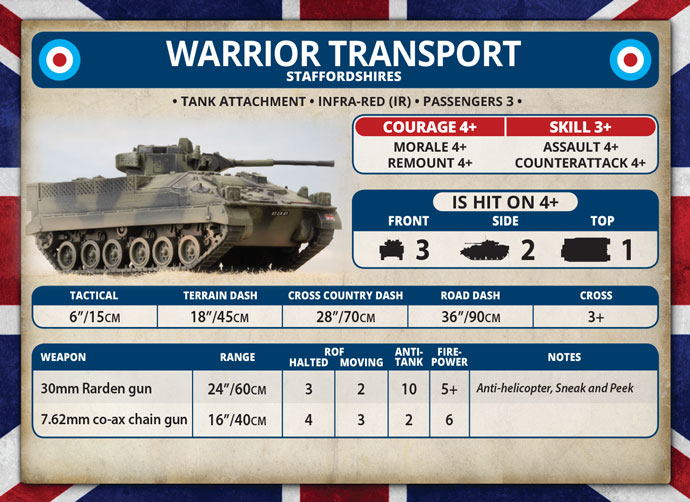 BMP-2, Marder, AMX-10P; Now the Warrior joins the ranks of decently armed IFVs. The effective 30mm Rarden gun gives the Warrior a fantastic amount of offensive power, combined with the anti- helicopter ability to keep pesky Hinds at bay.
BMP-2, Marder, AMX-10P; Now the Warrior joins the ranks of decently armed IFVs. The effective 30mm Rarden gun gives the Warrior a fantastic amount of offensive power, combined with the anti- helicopter ability to keep pesky Hinds at bay.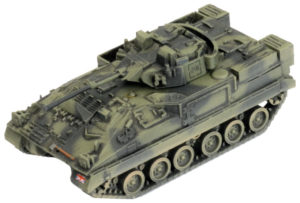 That’s the armament, but how is the armour? The regular Warrior is 5/3/1; a cut above the other IFVs in the bracket, and will remain one of the better armoured IFVs until the Yankees get the Bradley, and the Soviets get the BMP-3. But wait, ‘regular’? What do you mean ‘regular’? Well, the Warrior did come with an applique armour package, placing spaced armour round the sides. What is this going to do for the Warrior?
That’s the armament, but how is the armour? The regular Warrior is 5/3/1; a cut above the other IFVs in the bracket, and will remain one of the better armoured IFVs until the Yankees get the Bradley, and the Soviets get the BMP-3. But wait, ‘regular’? What do you mean ‘regular’? Well, the Warrior did come with an applique armour package, placing spaced armour round the sides. What is this going to do for the Warrior?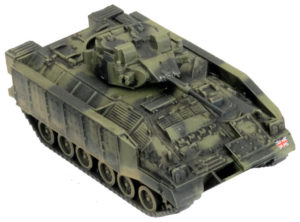 Strengths: 30mm Gun with anti-helicopter makes it a threat to most enemy forces, armour is effective against small arms, and infantry-carried anti-tank weapons
Strengths: 30mm Gun with anti-helicopter makes it a threat to most enemy forces, armour is effective against small arms, and infantry-carried anti-tank weapons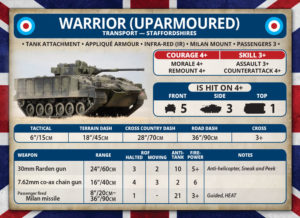 Okay, so maybe I haven’t done a complete comparison of the two forces, but I have slipped in some of the newer kit in the book to give them a run-out. As you can see the main formation for the Warrior Company is a lot smaller than the FV432 Formation (and I didn’t even give them the Uparmoured option!). Only two platoons of infantry, the mortars and MCTs are gone, as well as the anchors that were the Chieftains.
Okay, so maybe I haven’t done a complete comparison of the two forces, but I have slipped in some of the newer kit in the book to give them a run-out. As you can see the main formation for the Warrior Company is a lot smaller than the FV432 Formation (and I didn’t even give them the Uparmoured option!). Only two platoons of infantry, the mortars and MCTs are gone, as well as the anchors that were the Chieftains. Today I’d like to discuss one of the most radical changes of all – the Fox.
Today I’d like to discuss one of the most radical changes of all – the Fox.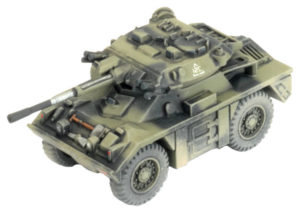 As a cost effective scout vehicle, the Fox hits hard.
As a cost effective scout vehicle, the Fox hits hard.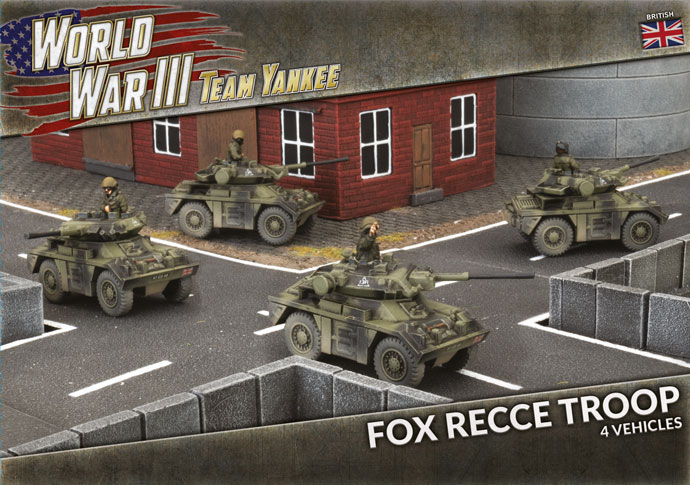 Where the Fox really shines is Road Dash of 48”/120cm compared to Scimitar 36”/90cm. With huge road networks in western Europe, this road dash is a fantastic improvement and really helps with the improved points level. There is no reason you should be going offroad as the road mobility
Where the Fox really shines is Road Dash of 48”/120cm compared to Scimitar 36”/90cm. With huge road networks in western Europe, this road dash is a fantastic improvement and really helps with the improved points level. There is no reason you should be going offroad as the road mobility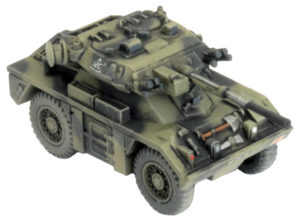 One fun fact about the Fox is that small numbers were used for airmobile support of British airborne forces. You can do this by choosing the support box option as noted above and use in support of an Airmobile Formation. Historically the Fox could even be parachuted into an operational area, giving the British Army a lightweight and fast support vehicle for their light airmobile forces.
One fun fact about the Fox is that small numbers were used for airmobile support of British airborne forces. You can do this by choosing the support box option as noted above and use in support of an Airmobile Formation. Historically the Fox could even be parachuted into an operational area, giving the British Army a lightweight and fast support vehicle for their light airmobile forces.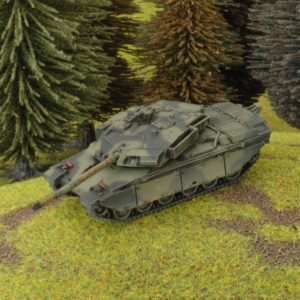 My current British army is based around a Chieftain squadron with a full 14 uparmoured Stillbrew Chieftains, some Swingfire missiles, a couple of Scorpions, a platoon of infantry and a little support. It’s a good little force, and I’m quite happy with its performance. However, my Chieftains have been usurped as the biggest tanks on the battlefield! The Challenger is even bigger!
My current British army is based around a Chieftain squadron with a full 14 uparmoured Stillbrew Chieftains, some Swingfire missiles, a couple of Scorpions, a platoon of infantry and a little support. It’s a good little force, and I’m quite happy with its performance. However, my Chieftains have been usurped as the biggest tanks on the battlefield! The Challenger is even bigger!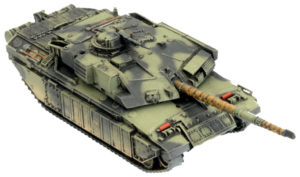

 I do think I’ll manage to resist the last two new plastic kits, the Fox armoured car and the MLRS rocket launcher. I’m tempted to get them to make into objectives, but they don’t really fit in the theme of my force. I already have a pair of Scorpions for reconnaissance, so the Fox, although cute, isn’t really needed, despite being a touch cheaper for four. The MLRS is pretty awesome for shutting down infantry with its big Salvo template and each launcher counting as two weapons, but I prefer to focus a little more, so my tanks don’t actually have any artillery support — although thinking about it, two MLRS for the price of another Chieftain might actually be a good idea…
I do think I’ll manage to resist the last two new plastic kits, the Fox armoured car and the MLRS rocket launcher. I’m tempted to get them to make into objectives, but they don’t really fit in the theme of my force. I already have a pair of Scorpions for reconnaissance, so the Fox, although cute, isn’t really needed, despite being a touch cheaper for four. The MLRS is pretty awesome for shutting down infantry with its big Salvo template and each launcher counting as two weapons, but I prefer to focus a little more, so my tanks don’t actually have any artillery support — although thinking about it, two MLRS for the price of another Chieftain might actually be a good idea… with Wayne Turner, Battlefront NZ
with Wayne Turner, Battlefront NZ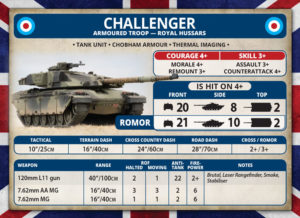
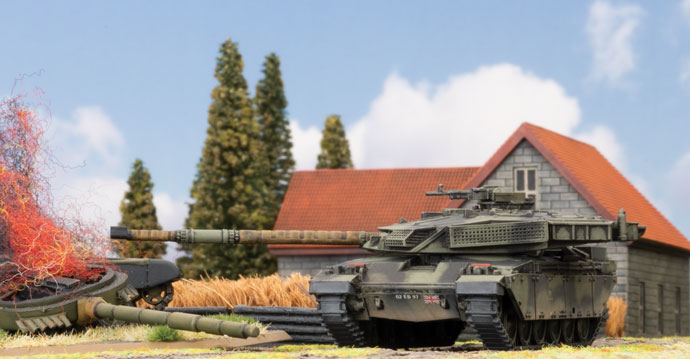 We have also included the option for ROMOR armour, which consisted of explosive reactive armour added to the front hull armour, and Chobham composite skirts in place of the bazooka skirts. This is an armoured package that was developed to apply to the Challenger in times of war to give the tank further protection.
We have also included the option for ROMOR armour, which consisted of explosive reactive armour added to the front hull armour, and Chobham composite skirts in place of the bazooka skirts. This is an armoured package that was developed to apply to the Challenger in times of war to give the tank further protection.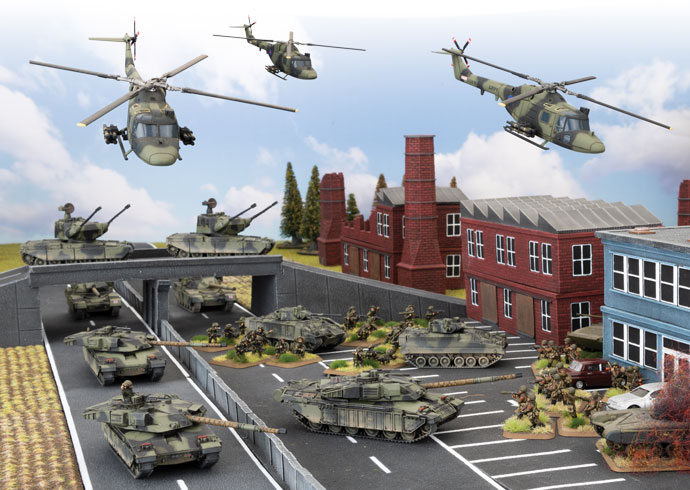
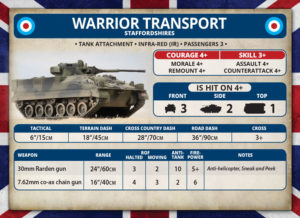 The Warrior was also used to carry the battalions Milan anti-tank guided missile teams. These two units either allow you to field the Warrior as a transport of the Milan missiles, or with the Milan mounted on the Warriors to be fired from the vehicle. The Warrior Anti-tank Section has the additional armour of the Up armoured version of the IFV as the Milan mounts were introduced with the additional armour package.
The Warrior was also used to carry the battalions Milan anti-tank guided missile teams. These two units either allow you to field the Warrior as a transport of the Milan missiles, or with the Milan mounted on the Warriors to be fired from the vehicle. The Warrior Anti-tank Section has the additional armour of the Up armoured version of the IFV as the Milan mounts were introduced with the additional armour package.
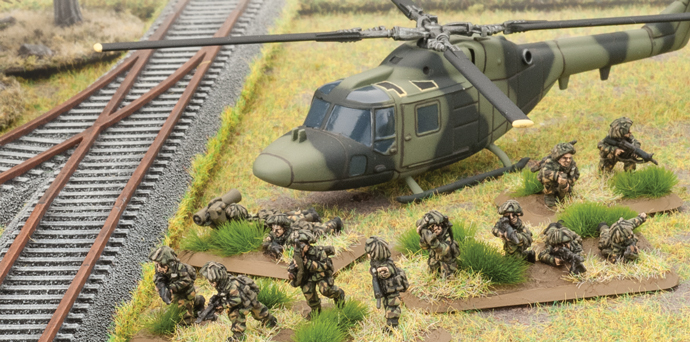 The formation comes with two Lynx Airmobile Platoons and a Lynx Milan Platoon for anti-tank support. The Lynx Airmobile Platoons have the same composition as the Mechanised Platoon, replacing the armoured transports with Lynx Transport Helicopters.
The formation comes with two Lynx Airmobile Platoons and a Lynx Milan Platoon for anti-tank support. The Lynx Airmobile Platoons have the same composition as the Mechanised Platoon, replacing the armoured transports with Lynx Transport Helicopters.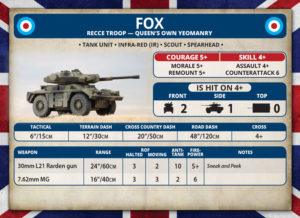
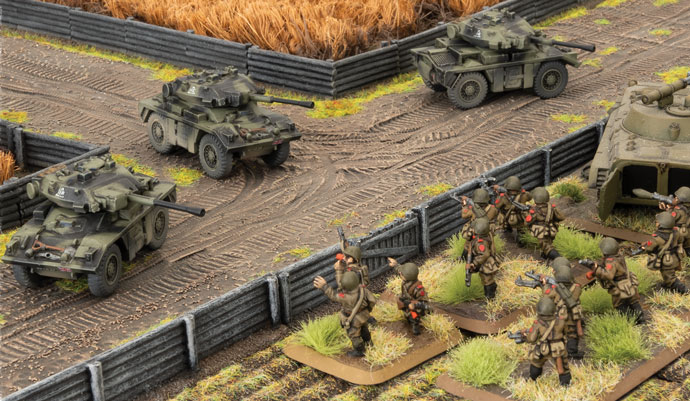
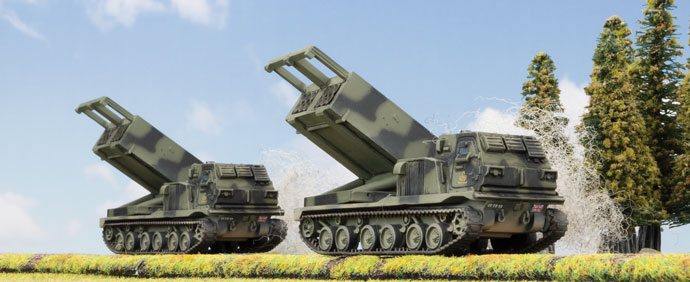
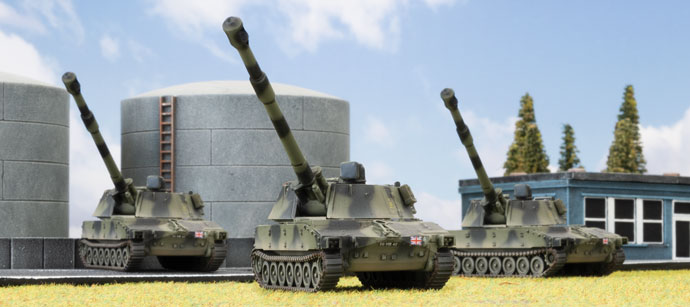
 To destroy tanks from the air the British also employ the TOW Lynx HELARM Flight. The Lynx HELARM is armed with the American TOW anti-tank guided missile with an HEAT anti-tank rating of 21. The Lynx HELARM uses the Hunter-killer rule that allows it to use terrain for concealment and remain Gone to Ground unless it shoots.
To destroy tanks from the air the British also employ the TOW Lynx HELARM Flight. The Lynx HELARM is armed with the American TOW anti-tank guided missile with an HEAT anti-tank rating of 21. The Lynx HELARM uses the Hunter-killer rule that allows it to use terrain for concealment and remain Gone to Ground unless it shoots.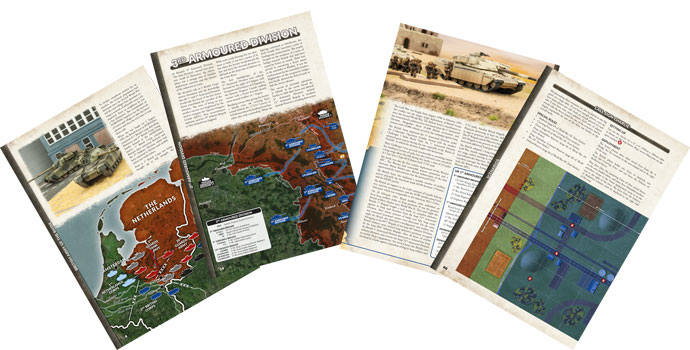


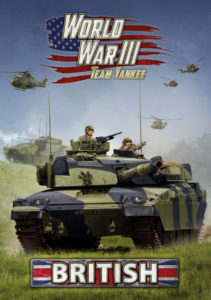 The WWIII: British Live Launch will be kicking off on Friday 14! You can expect to see articles from the WWIII: Team Yankee community celebrating the launch of the first book of the new WWIII: Team Yankee. New unit showcases, hobbying articles, battle reports, as well as the usual historical content, photographs and community content.
The WWIII: British Live Launch will be kicking off on Friday 14! You can expect to see articles from the WWIII: Team Yankee community celebrating the launch of the first book of the new WWIII: Team Yankee. New unit showcases, hobbying articles, battle reports, as well as the usual historical content, photographs and community content.